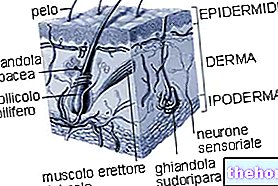Intervertebral Disc - Structure and Functions
The intervertebral disc is a real natural shock absorber, interposed between one vertebra and the other with the aim of attenuating the pressures developed during movements, for example while jumping, running or being shaken on the car seat. Despite this, the functions of the intervertebral disc extend well beyond its, however very important, antishock action. This cushion, in fact, gives the superimposed vertebrae a certain motility so that the spine can, within certain limits, bend in all directions and perform moderate rotational movements; if intervertebral discs did not exist, the vertebrae would have, due to their anatomical conformation, an even more limited articular excursion.
The intervertebral disc is a flexible fibrocartilage structure; it has the shape of a biconvex lens that adapts well to that of the vertebral bodies to which it is interposed. Two parts can be recognized in each disc:
- the pulpy nucleus: a central mass, gelatinous, yellowish and made up of highly hygroscopic mucopolysaccharides (they retain water); it has the purpose of responding to the stresses of the forces acting on the column and of distributing them uniformly to the annulus.
- l "ANULUS FIBROSO: solid and concentric peripheral scaffold, whose fibers are arranged in regular concentric layers that cross each other. Its purpose is to contain and protect the central core and gives the disc great resistance to compression.
The function of the discs is particularly important in the lumbar region, where the vertebrae are most stressed by the overlying load. For this reason, between L1 and L5, the intervertebral discs reach a greater and proportionally greater thickness than the vertebral bodies. This ratio, equal to 1/3, drops to 1/4 in the cervical vertebrae and to 1/7 in the dorsal vertebrae, also for this reason with less mobility.
In addition to varying slightly in shape depending on the location of the spine, the intervertebral discs are usually thicker in the anterior part (directed towards the abdomen); they are also absent between the sacral and coccygeal vertebrae, as well as between the first two cervicals.
The intervertebral discs are connected, anteriorly and posteriorly along the entire column, by fibrous ligaments which constitute a powerful reinforcing structure.
The adult intervertebral discs do not have a blood supply; thin blood vessels enter and leave the disc in the first years of life, but then tend to disappear around the age of 20-30. Consequently, the intervertebral disc obtains its nourishment essentially by osmosis from the capillary beds that surround it, in the same way it eliminates waste substances. This mechanism is activated by the pressure changes inside the disc, generated during the movements of the column.
Degeneration of the intervertebral discs
When pressure is applied to the intervertebral disc, the nourishing fluids flow out and reduce its thickness. Conversely, when the pressure is removed (for example during sleep or using an inversion bench) liquids are recalled inwards and their structure restored. It is known, in fact, that the height upon awakening is about two centimeters. higher than that measured at the end of a working day, since each intervertebral disc undergoes daily variations equal to 10% of its thickness.
In young people, the various discs make up 25% of the height of the spine, but this percentage is likely to decline with aging. The advancing age, in fact, brings with it a progressive and irreversible loss of water and functionality of the intervertebral disc, which turns into a "discharged shock absorber".
While the water content in the discs of young people is around 80-85%, in the elderly this percentage drops below 70%.

According to Nachesom, the pressure on the third lumbar disc varies considerably according to the position assumed. Once the load exerted in the natural upright posture is 100%, the pressure is reduced to 25% in horizontal decubitus and increases to 150% in the seated position and to 180% in anterior flexion of the trunk.
(Nachemson A - The Lumber Spine - An Orthopedic Challenge: Spine 1:59 - 71, March 1976)
If the stresses to which the intervertebral disc undergoes are particularly intense, the resistance of the annular container can be overcome and produce a displacement of the nucleus from its central position. The same result can be the consequence of a chronic exposure to vibrations and wearing stresses, which considerably lower the annulus tolerance threshold. In these cases, we speak of disc herniation, which can occur in different degrees and types, to depending on the mode of displacement of the core.
In severe cases, the nucleus pulposus separates completely from the intervertebral disc, like a "crushed denitrific". Depending on its location, the prolapse can cause pain or symptoms of paralysis in the back, which sometimes also extend to the legs and feet and / or arms and hands. These symptoms are the result of a direct compression of the disc on the adjacent nerve roots and their irritation due to the release of inflammatory agents resulting from the degradation of disc proteins.
The weakest point of the disc is located in the posterior part of the fibrous nucleus, near the intervertebral foramen, which is why most herniations occur at this level.
Among the many treatment options, but in a few selected cases (given the delicacy and invasiveness of the operation), there is the possibility of replacing the injured intervertebral disc with an artificial prosthesis.

















.jpg)











